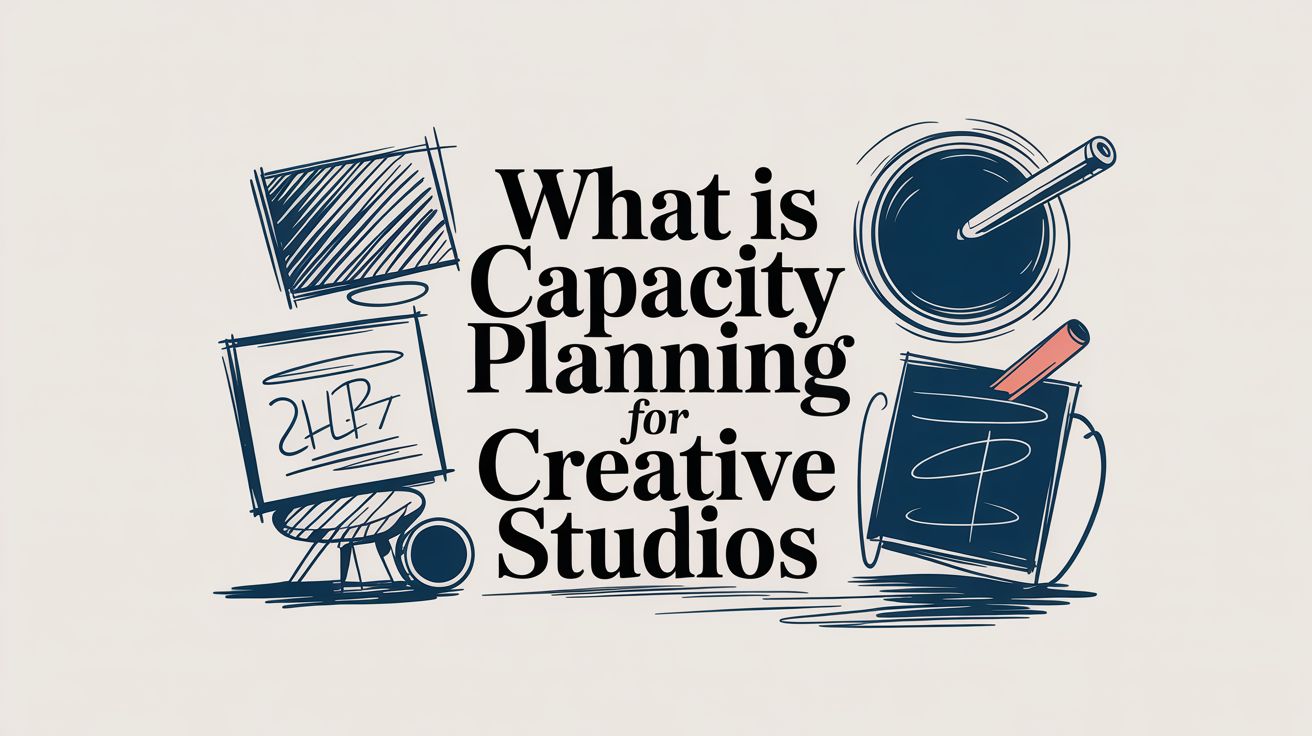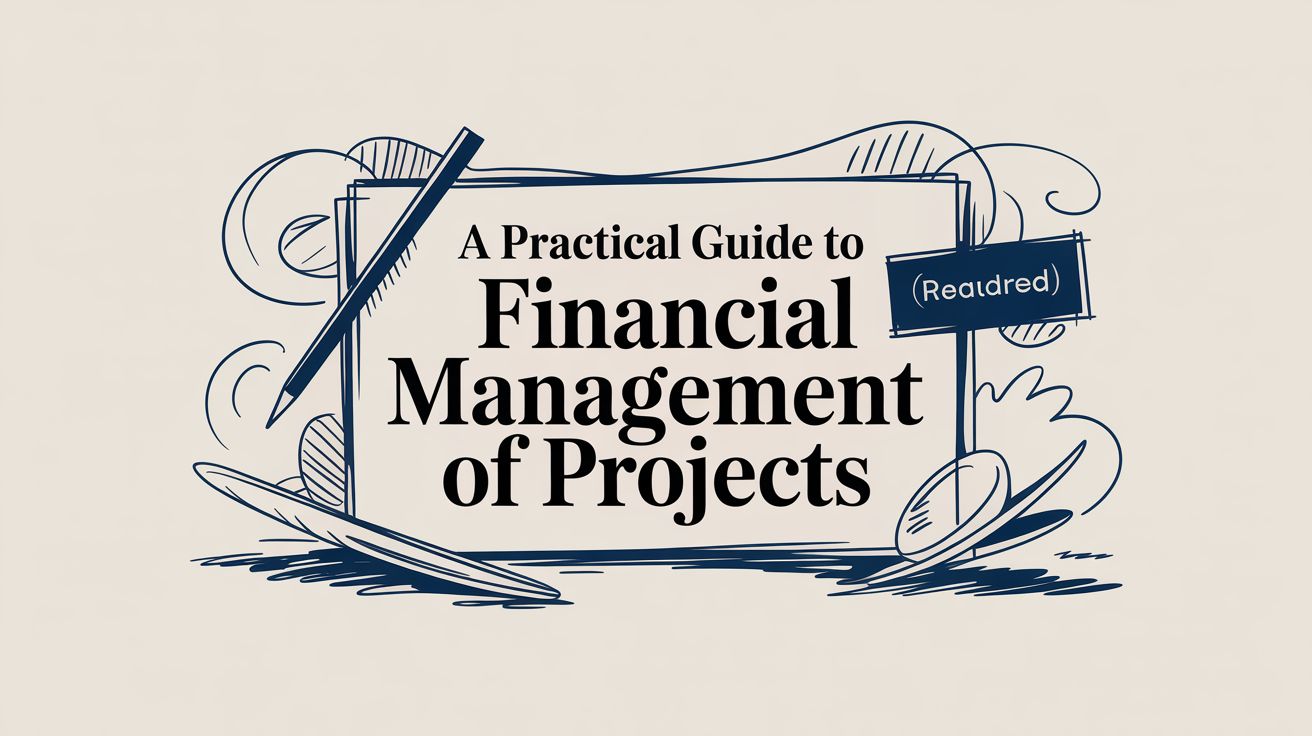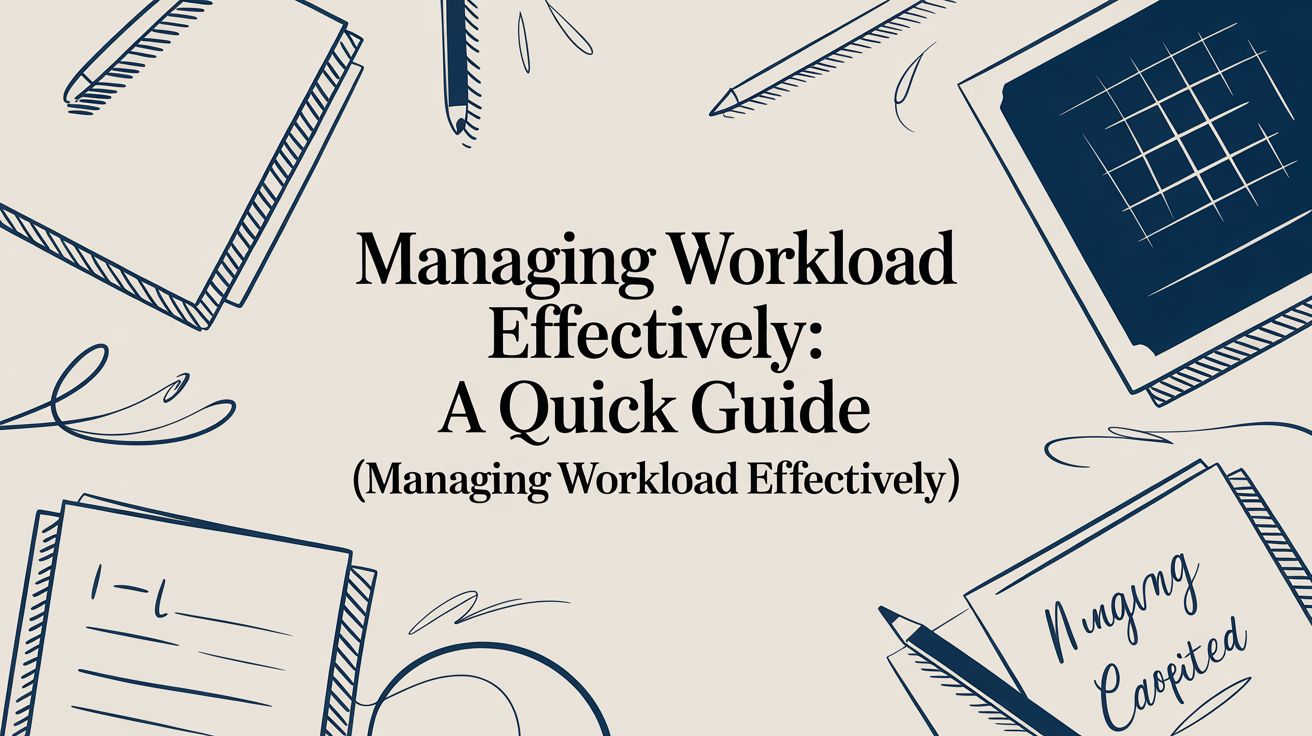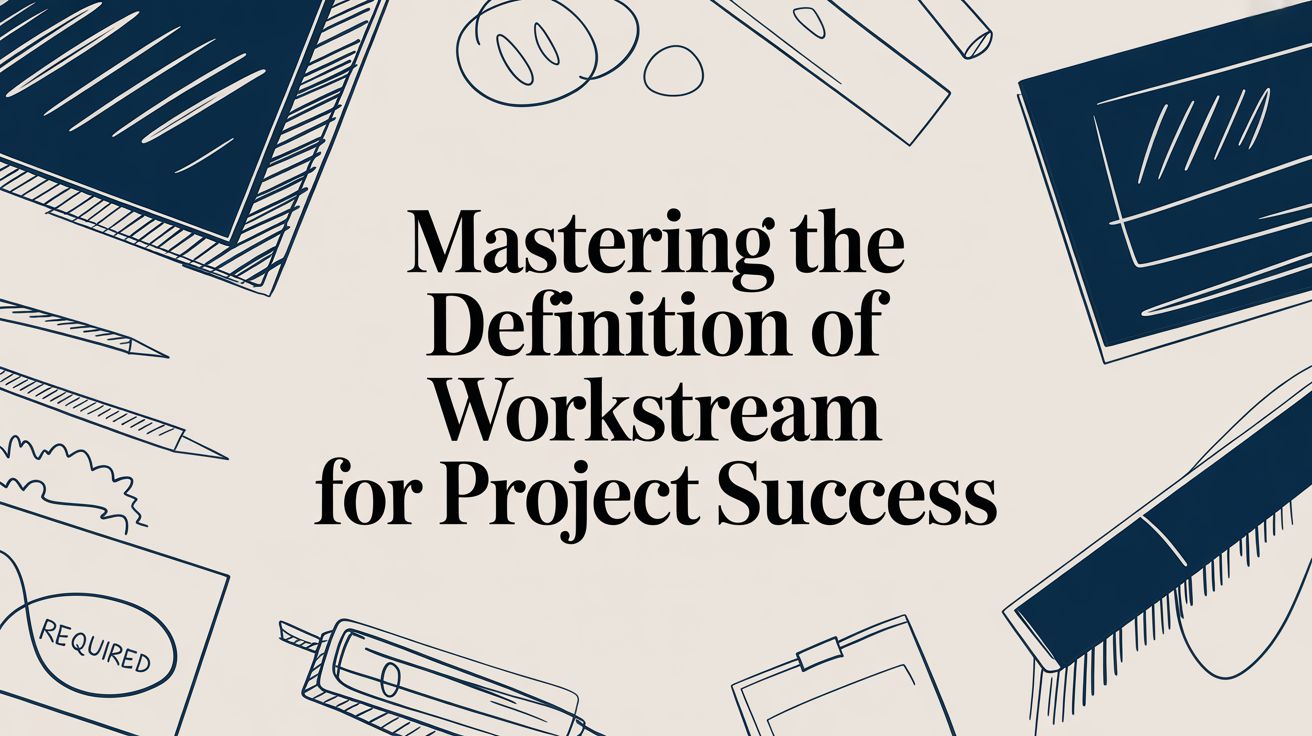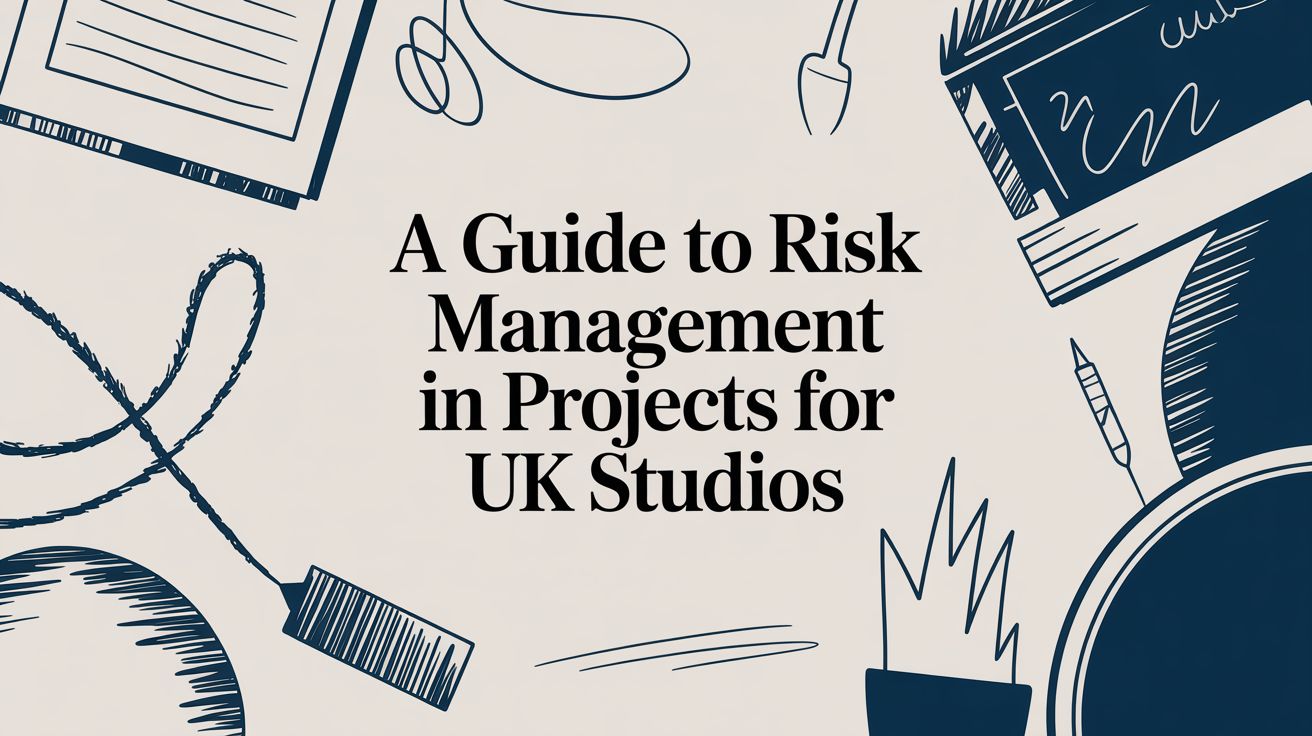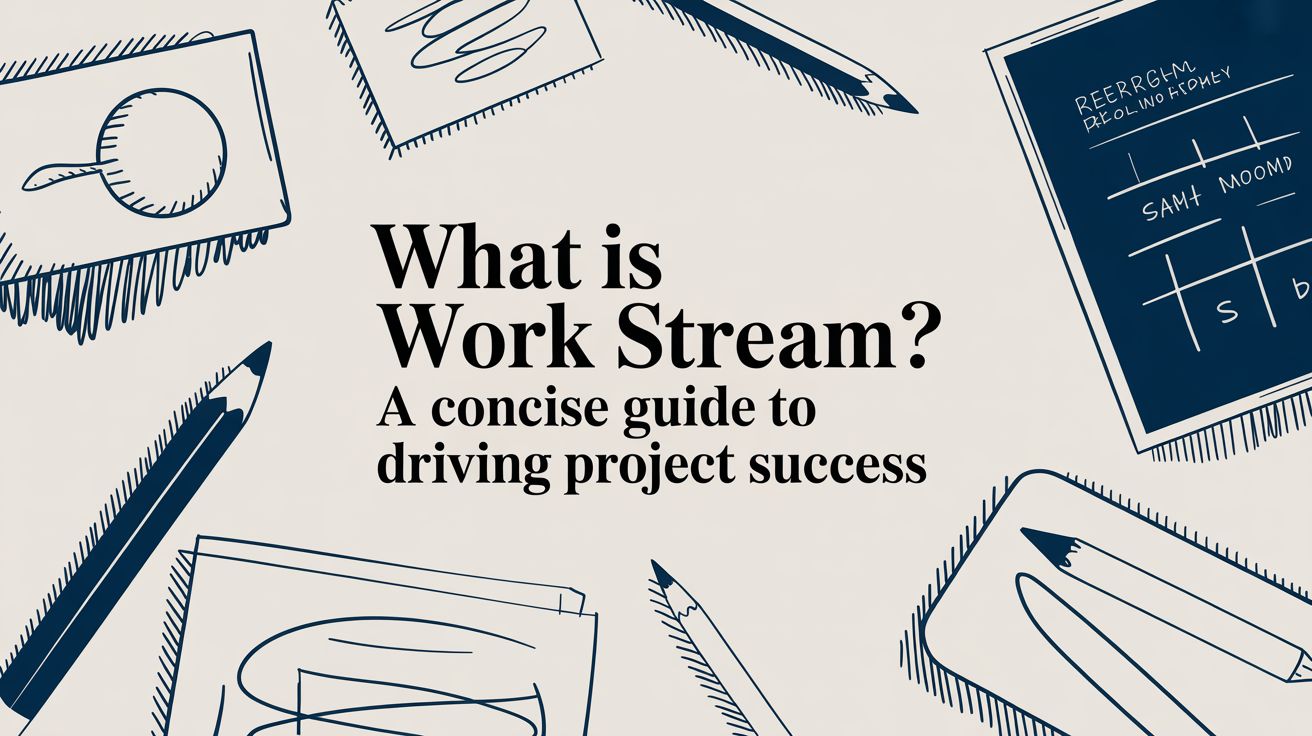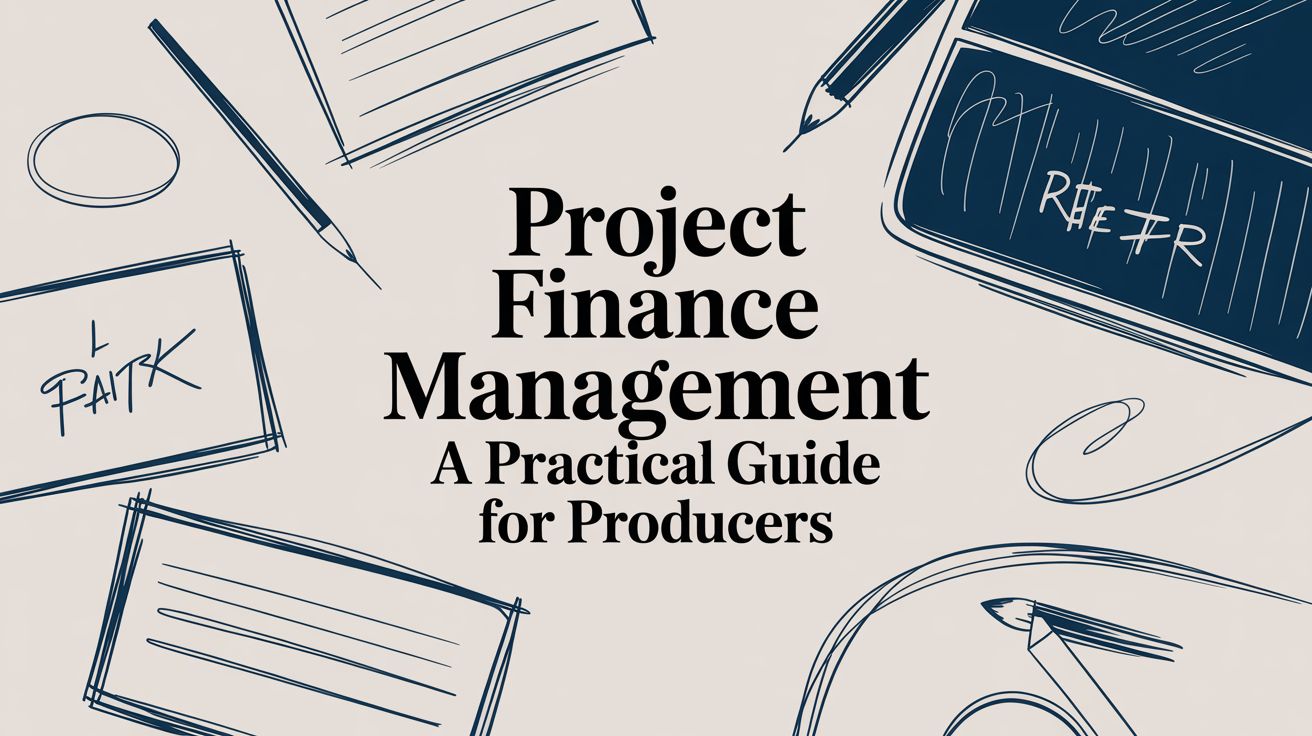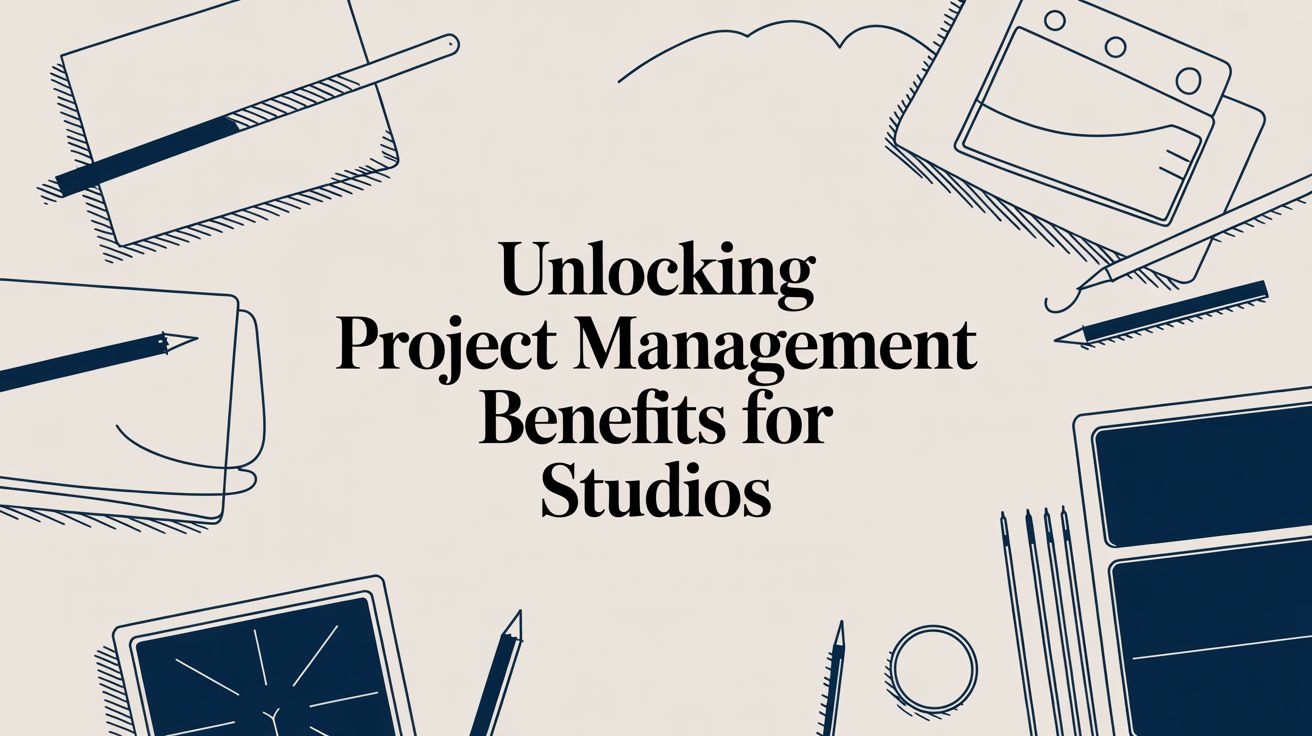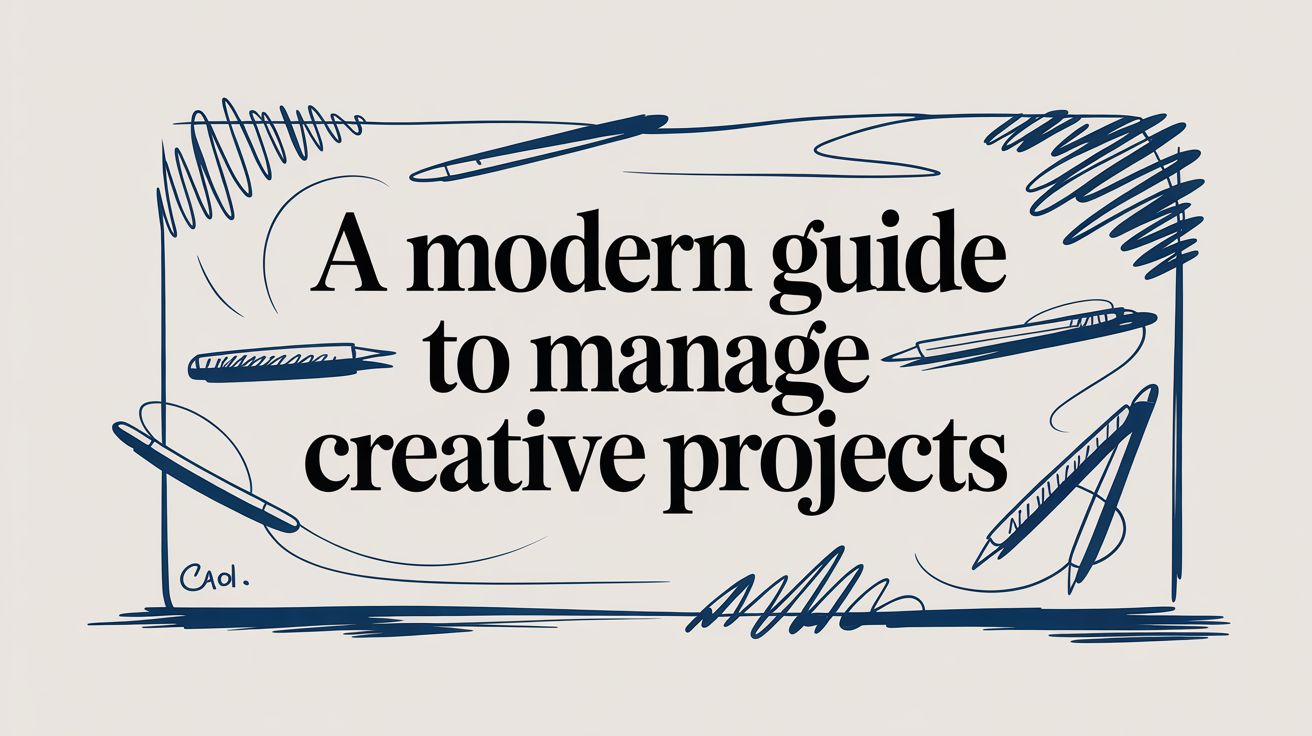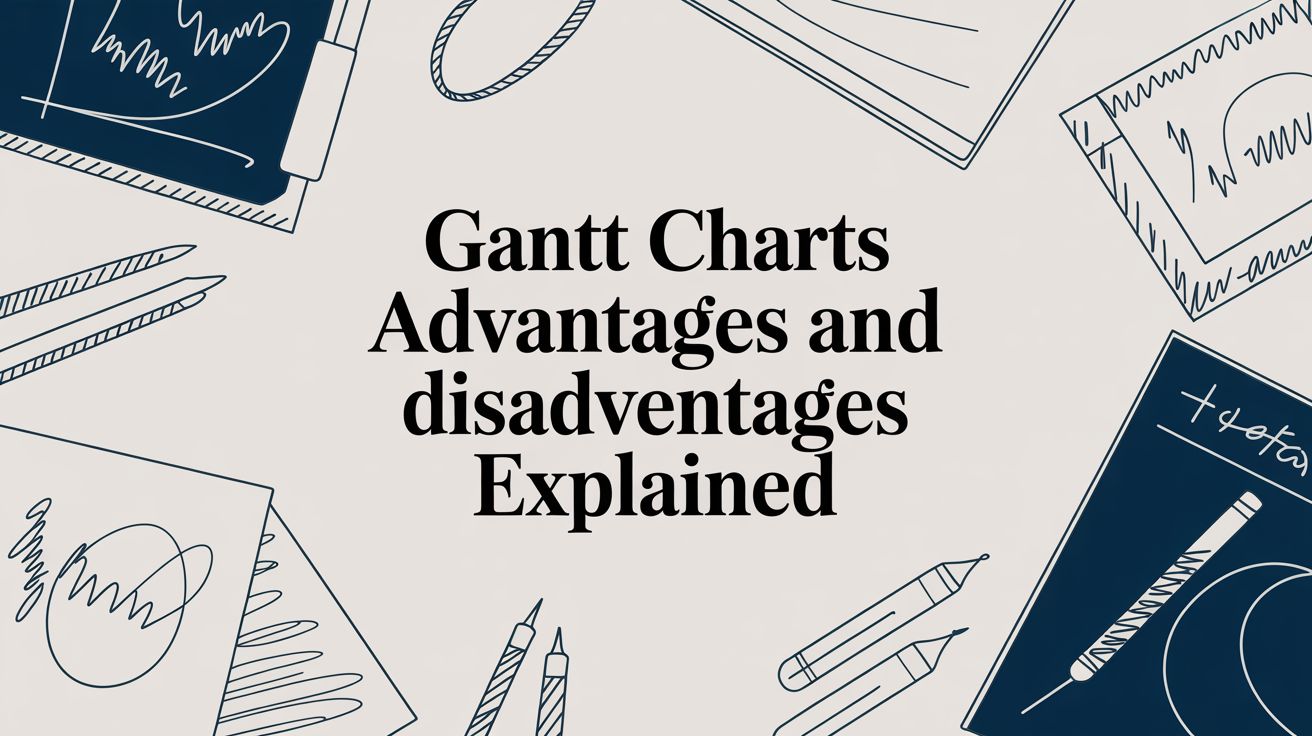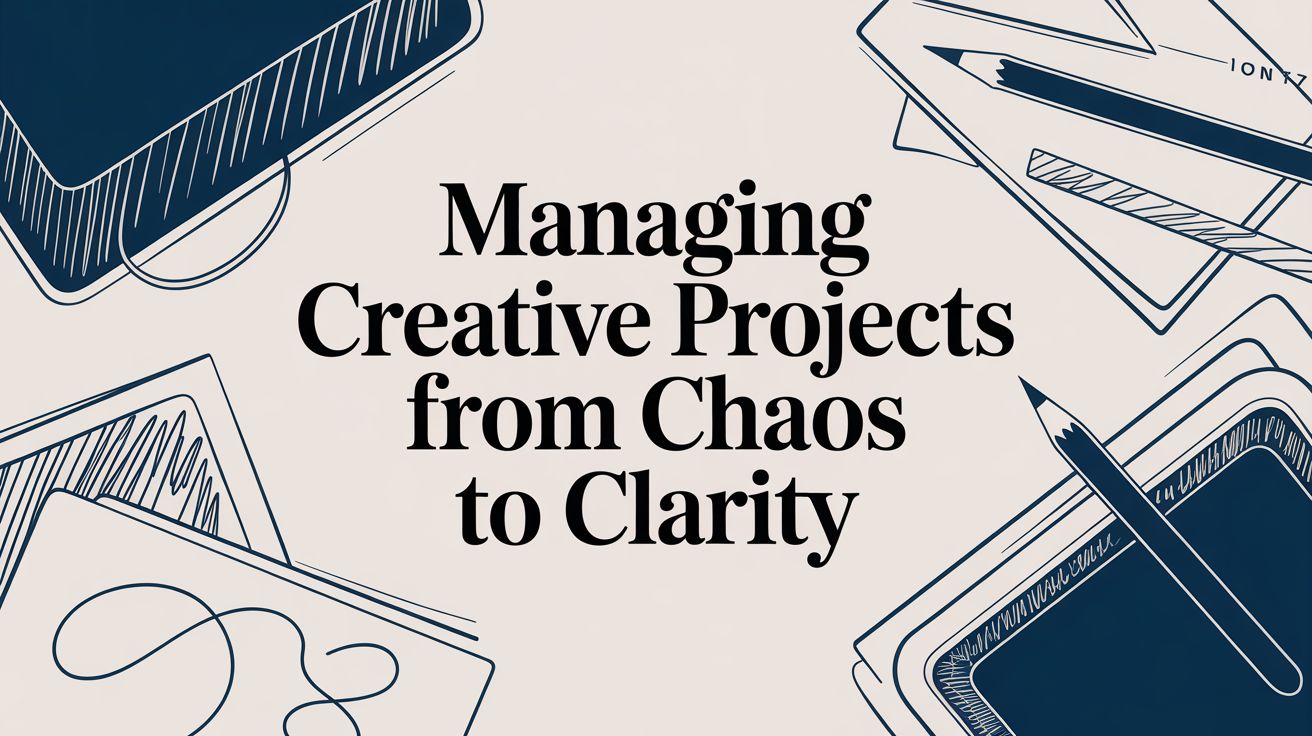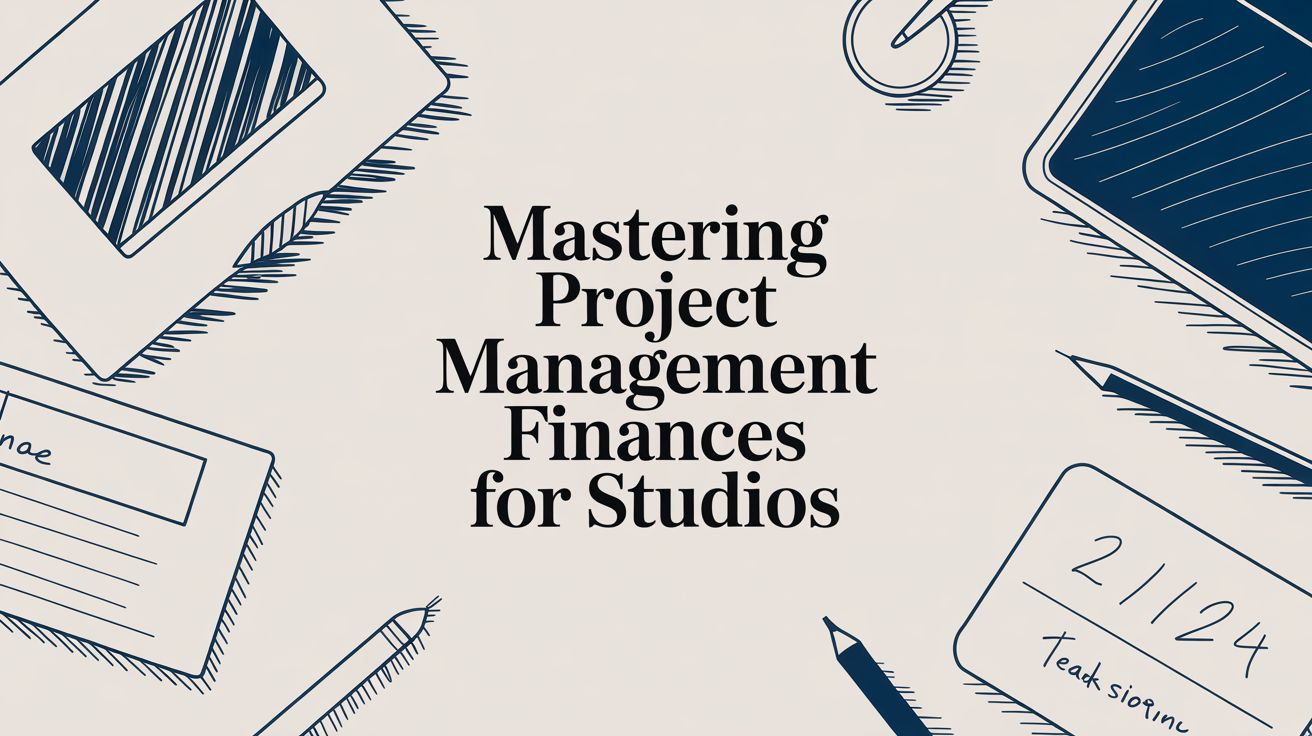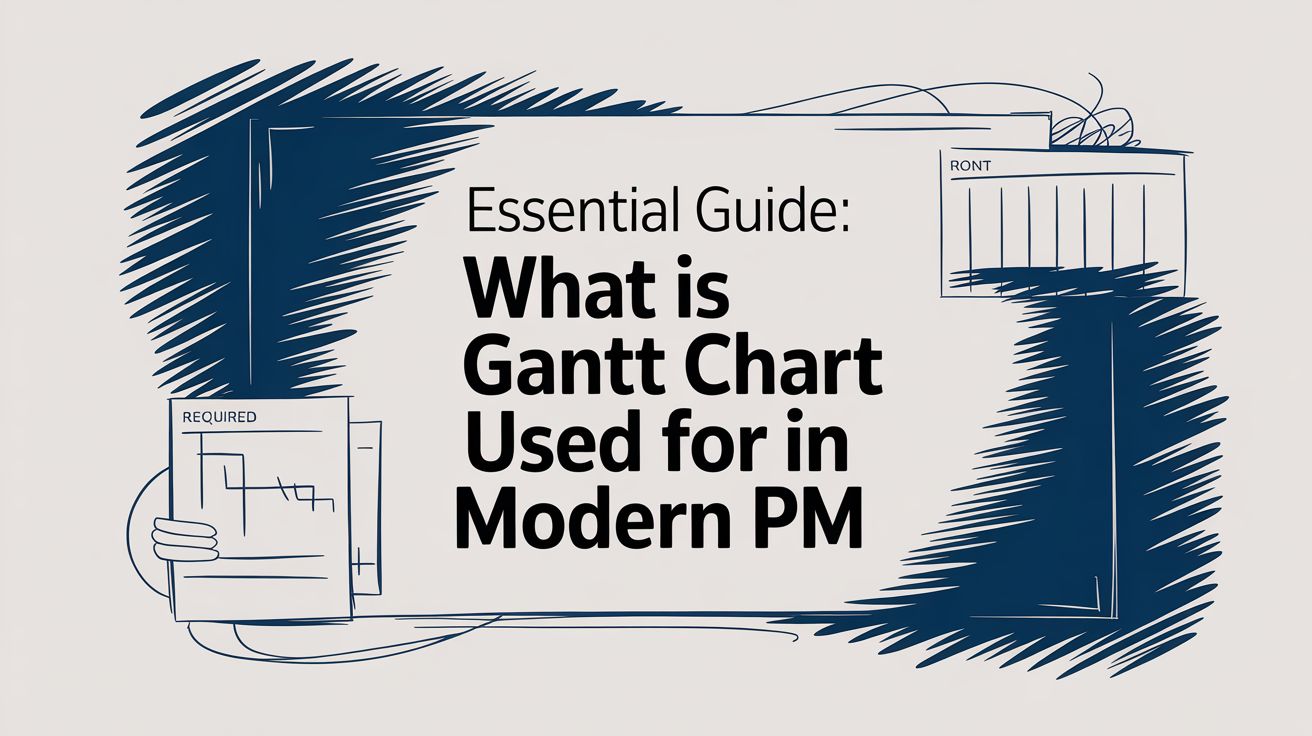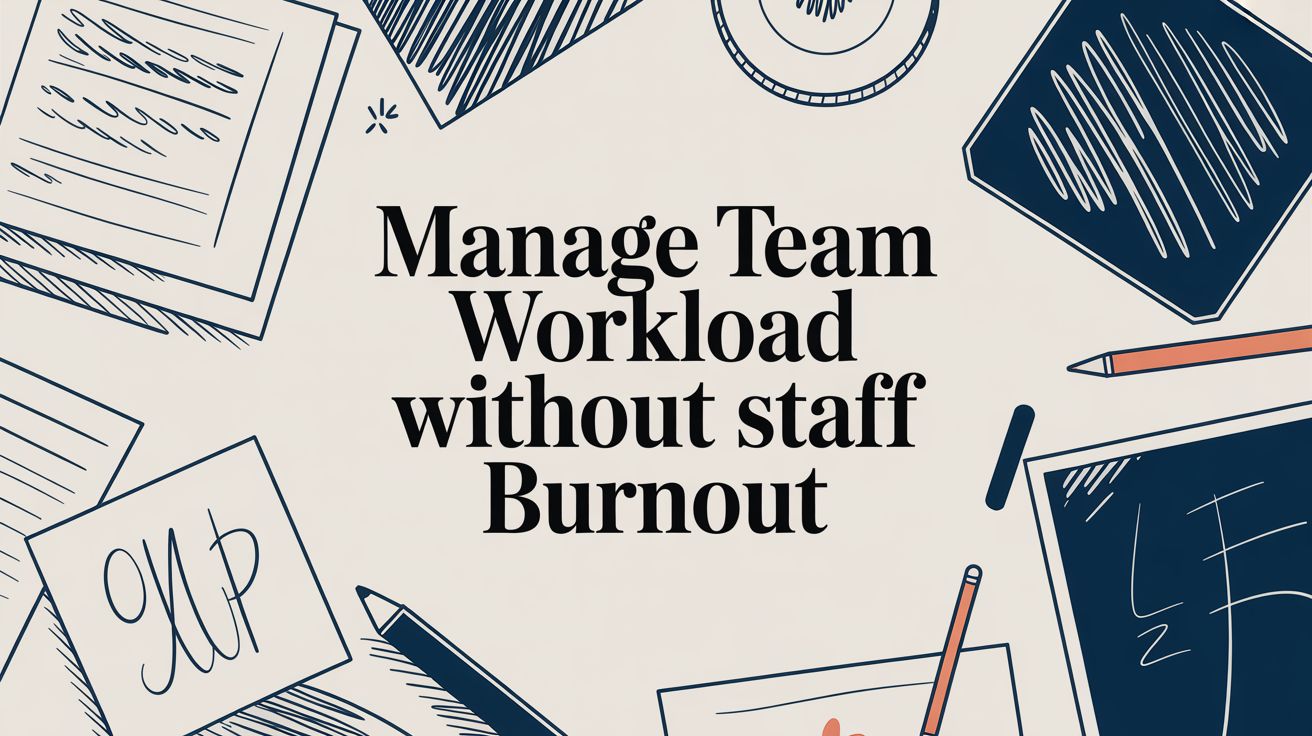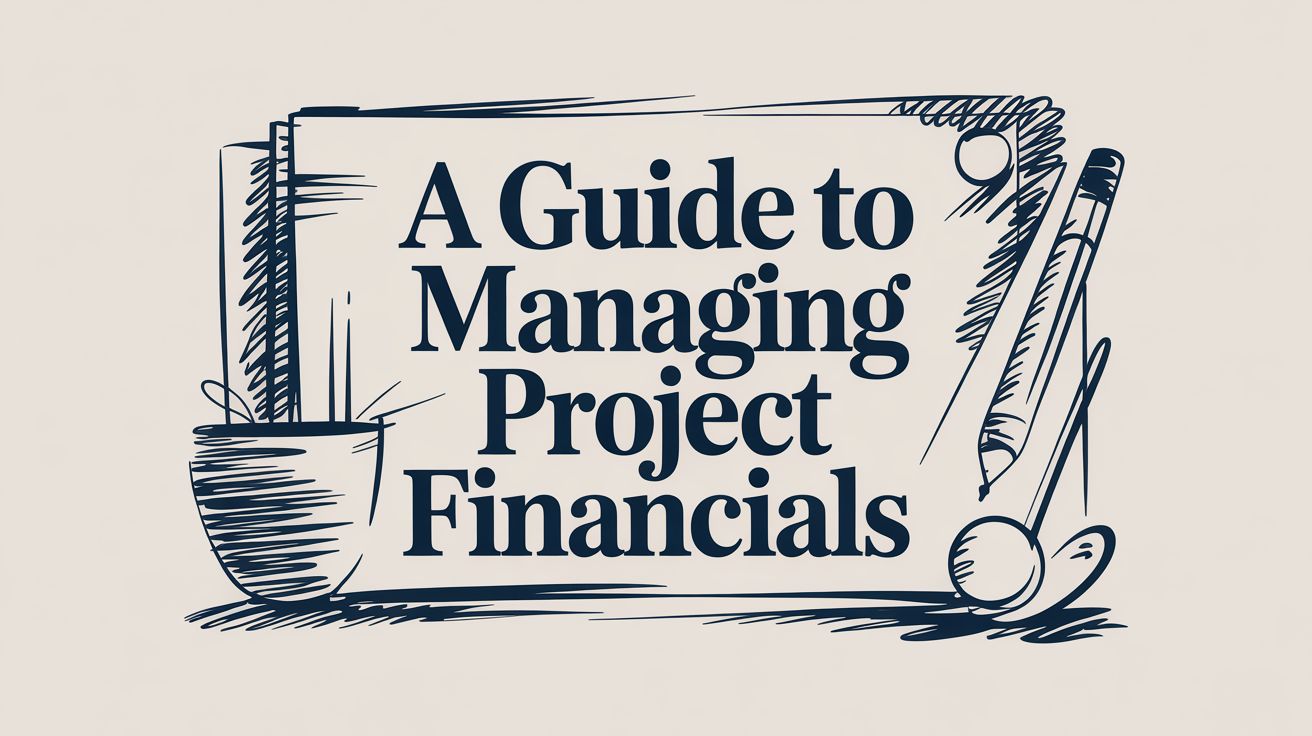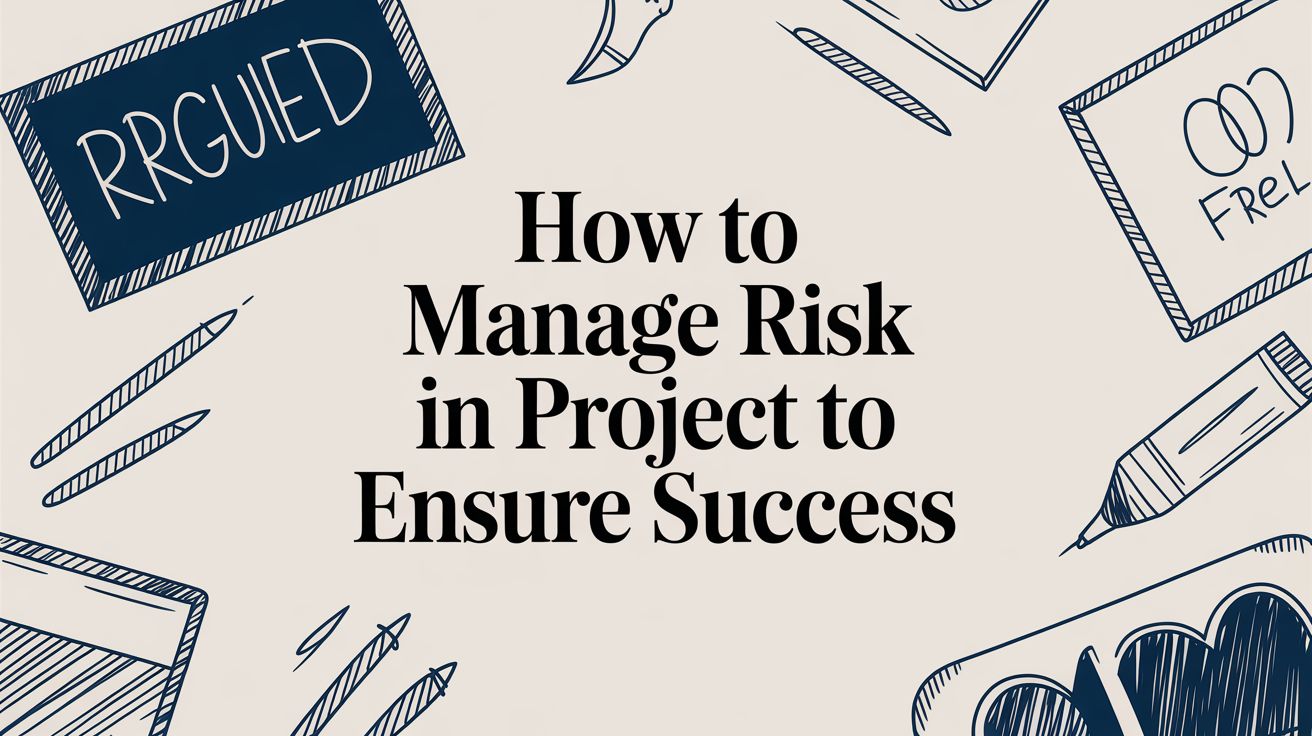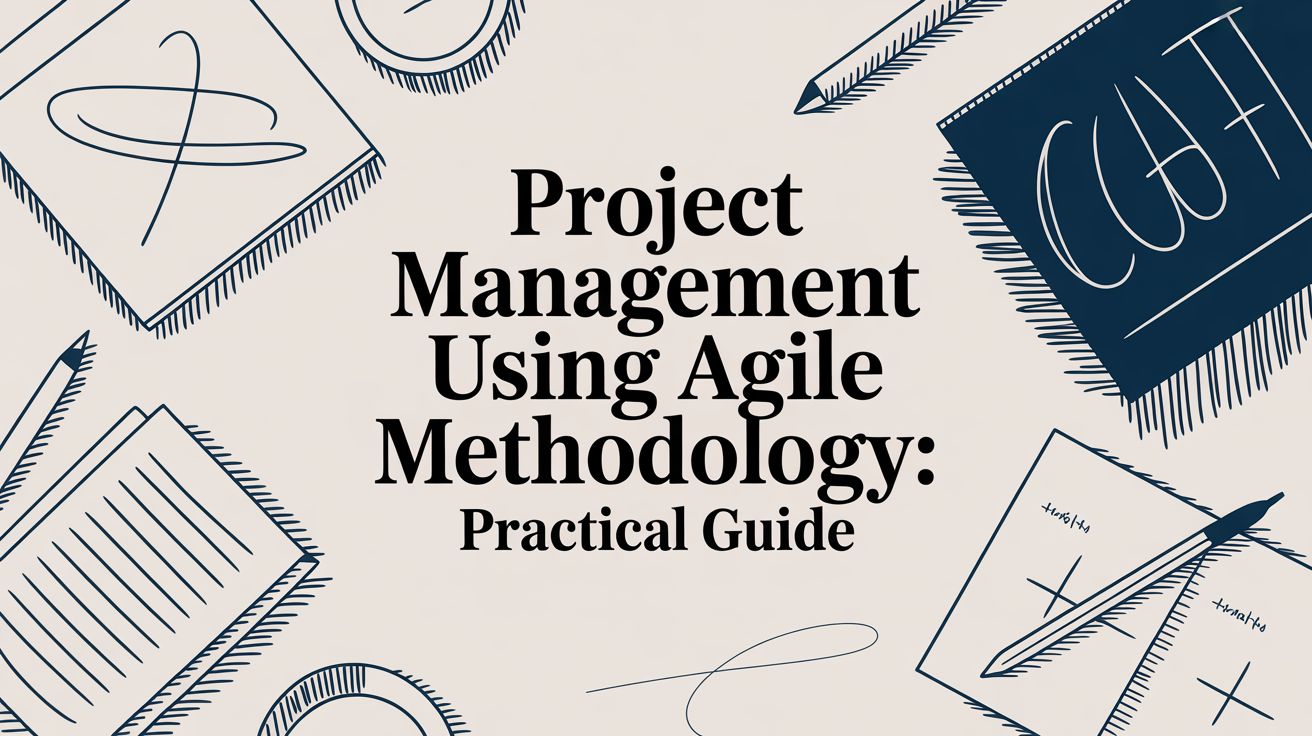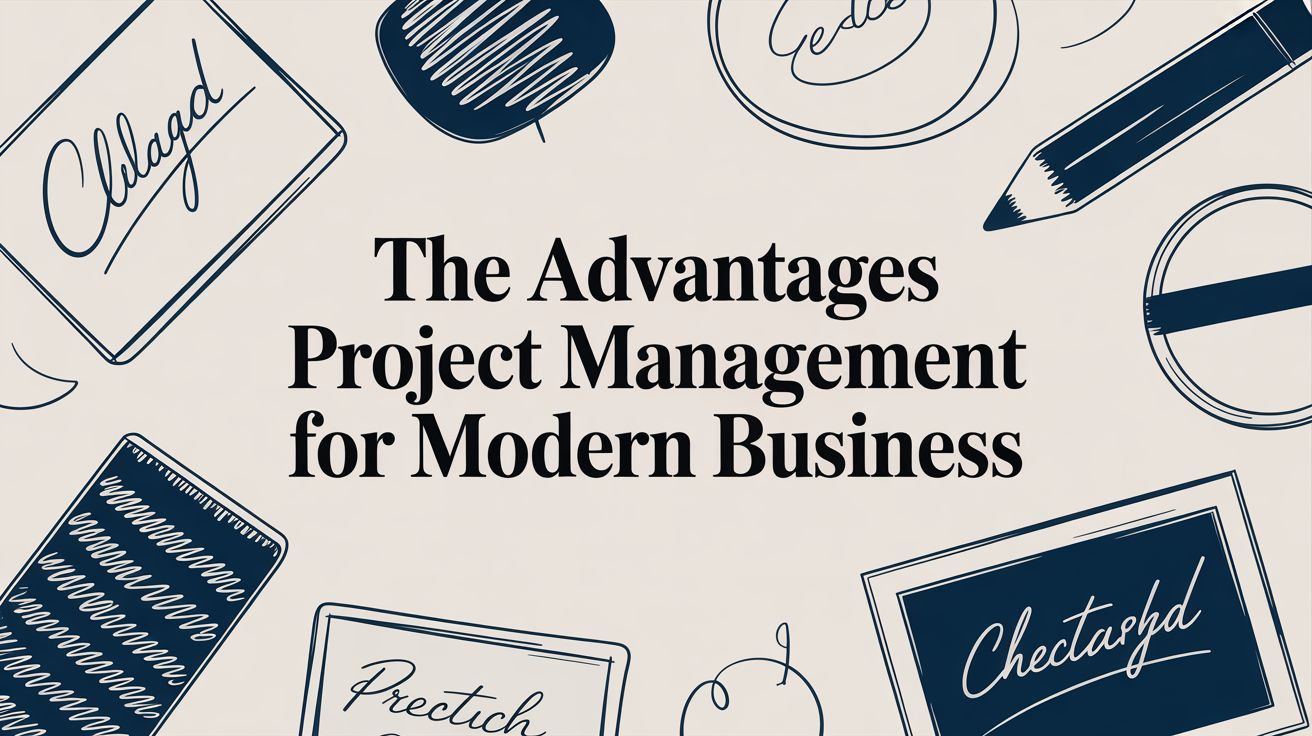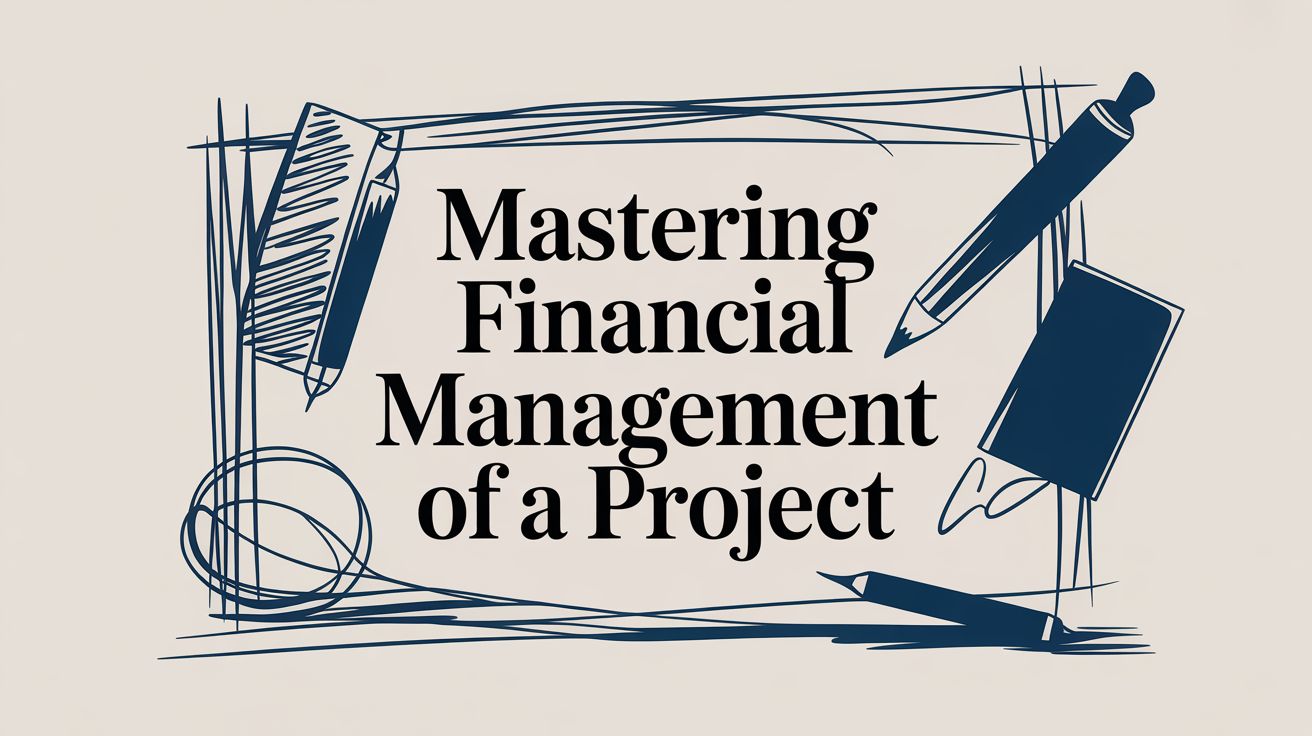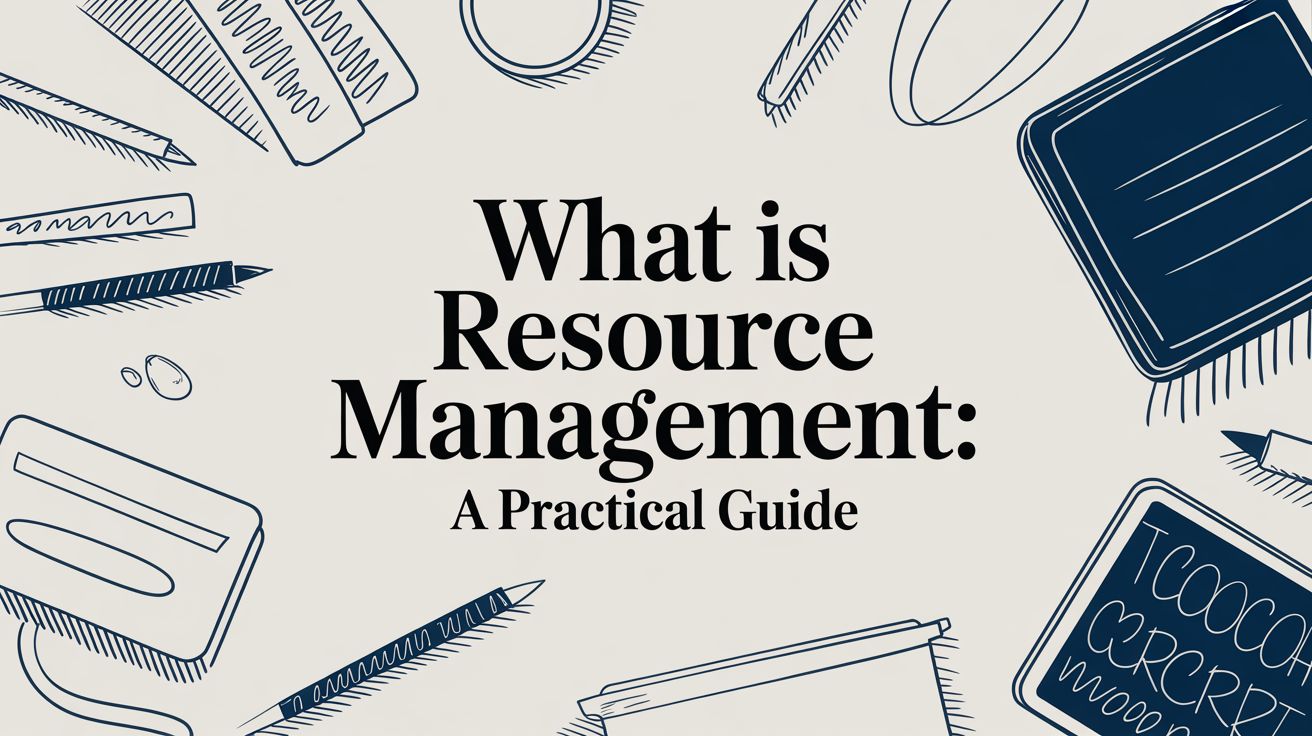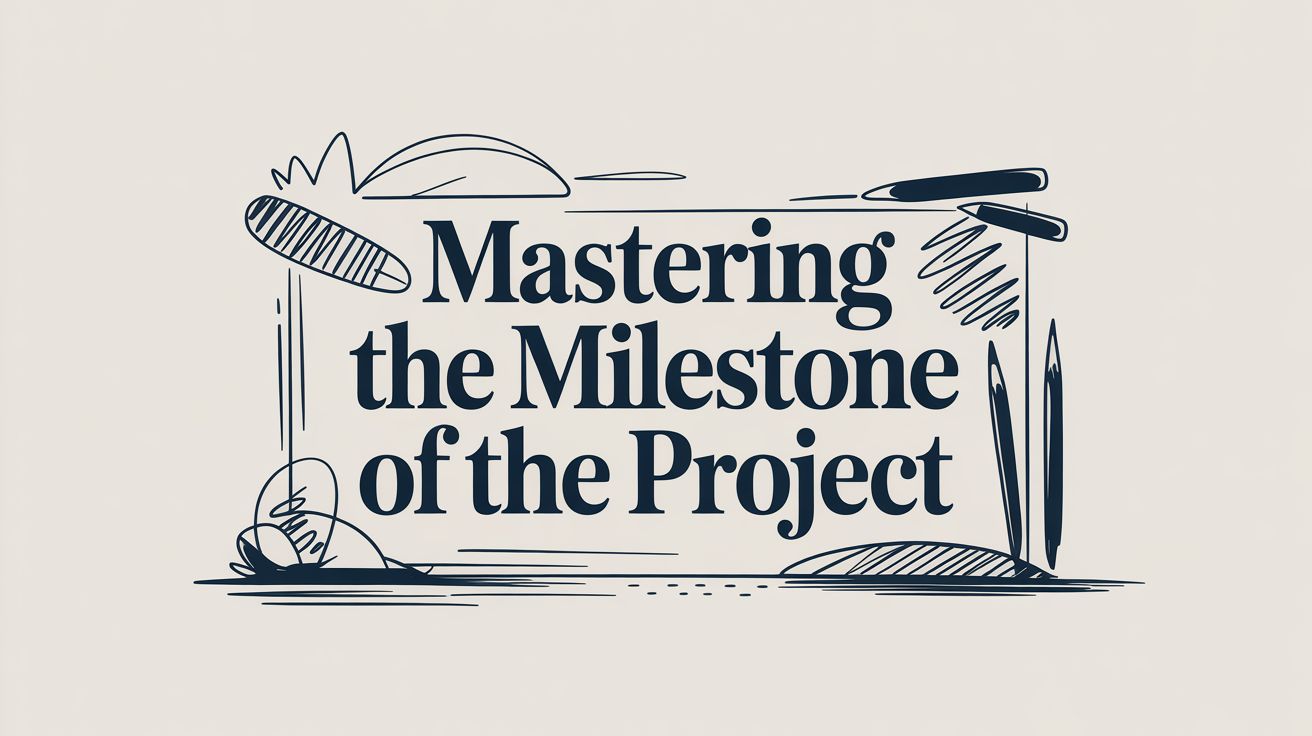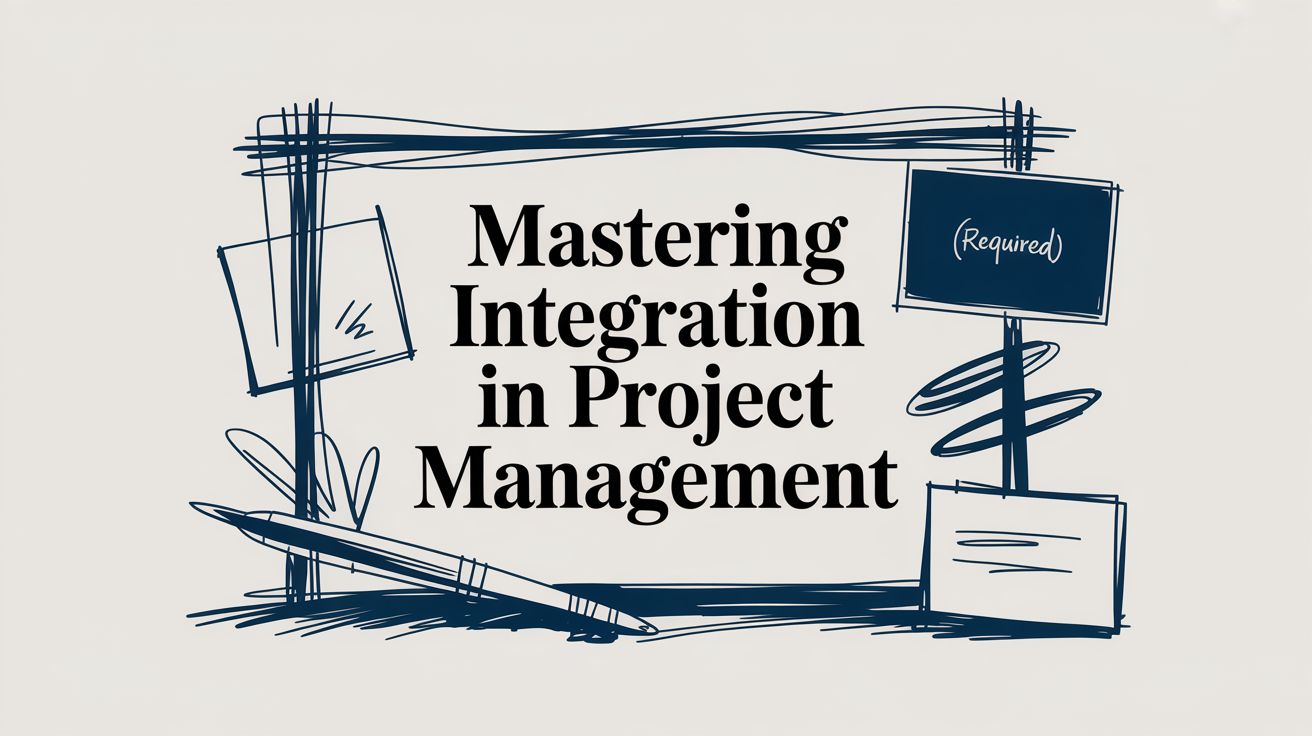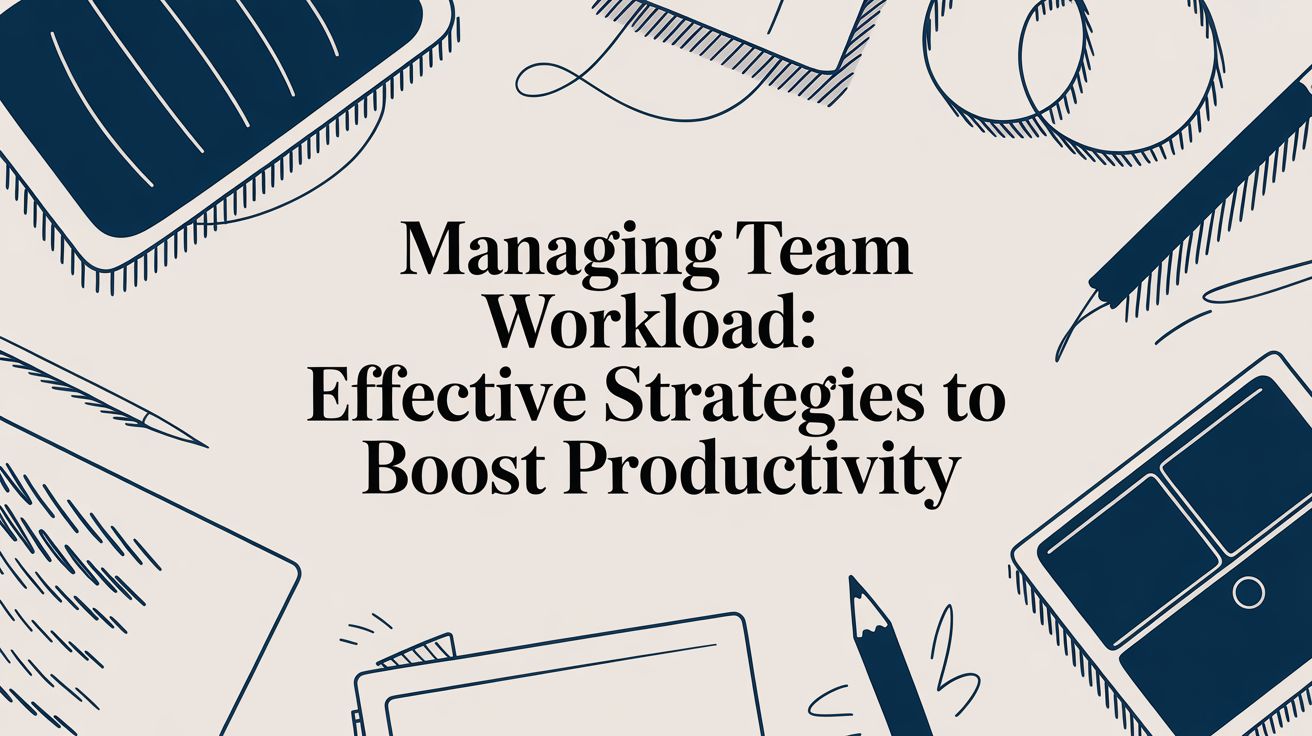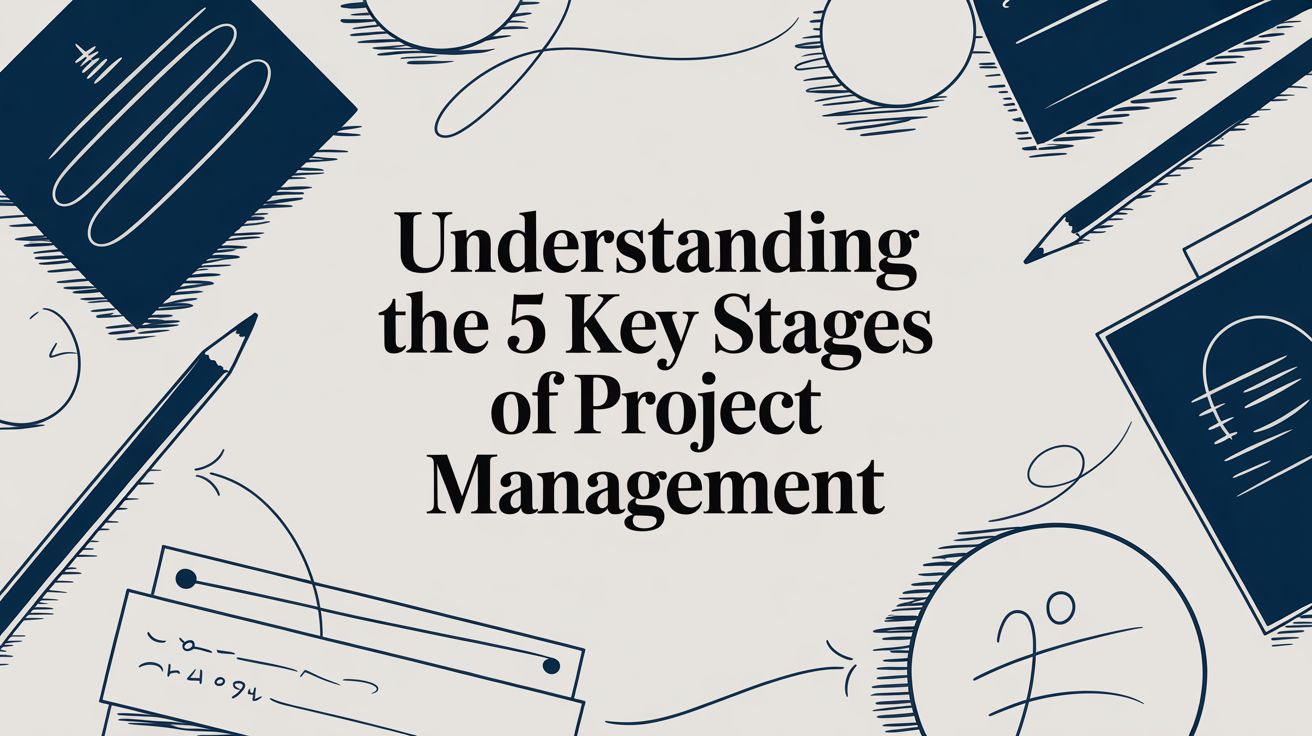Let's be honest, capacity planning sounds like something you’d hear in a factory, not a creative studio. But at its core, it’s simply the art of matching your resources—your incredible artists, your high-spec suites—with the actual work coming through the door. For post-production, it's the secret sauce that turns creative chaos into profitable, predictable delivery.
It’s all about making sure you have the right people, with the right skills, available at exactly the right time.
Defining Capacity Planning for Creative Studios
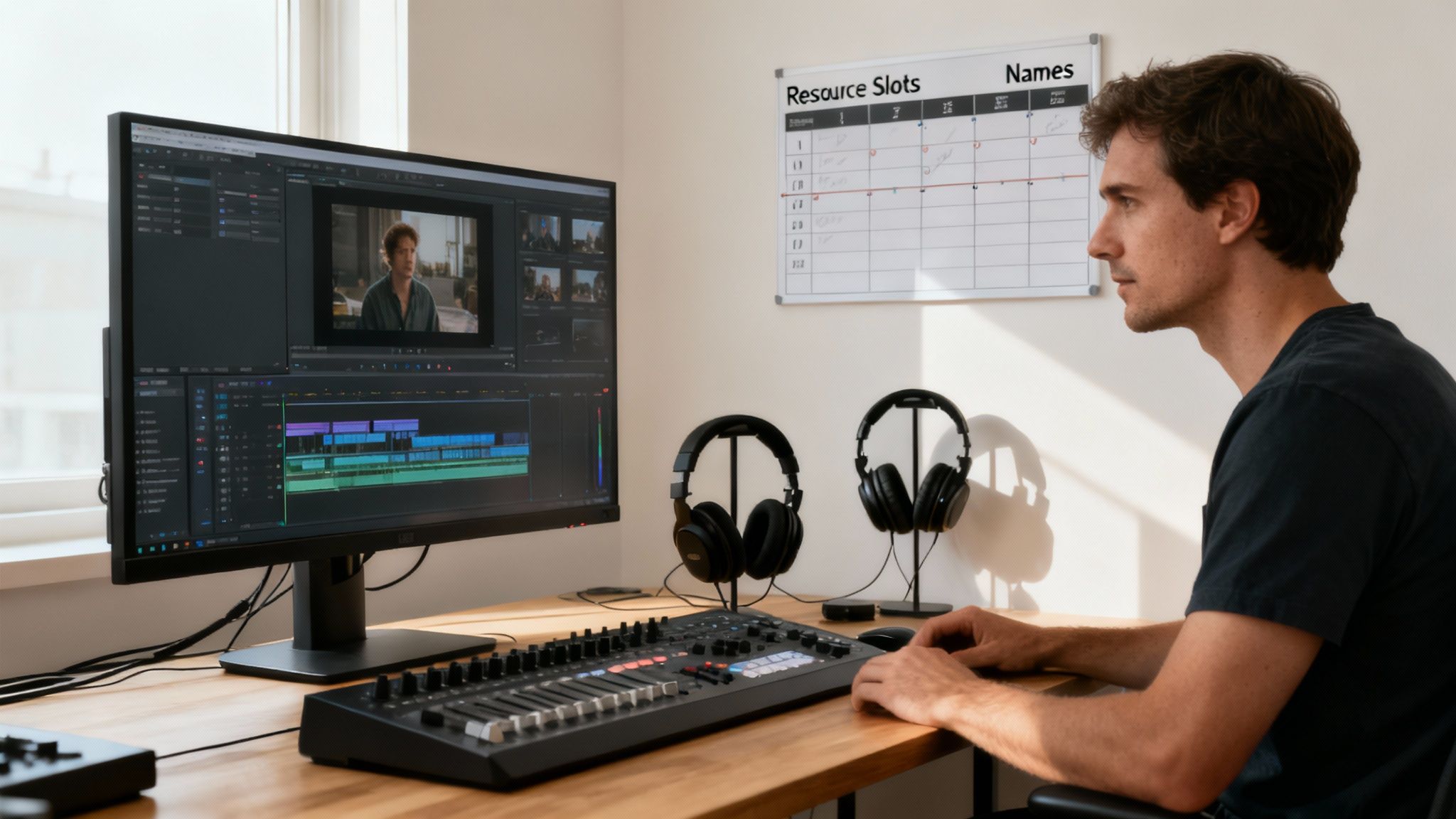
Think of running a busy restaurant kitchen during the dinner rush. You need enough chefs, the right number of cooking stations, and a clear system to get incredible meals out on time. A post-production studio is exactly the same, just with edit suites instead of stovetops. That’s capacity planning in a nutshell.
It’s the proactive process of balancing your studio’s supply of talent and tech with the demand from your project pipeline. This is so much more than a spreadsheet exercise; it's a fundamental business practice that directly hits your bottom line, keeps clients happy, and stops your team from burning out.
From Reactive Scrambles to Proactive Strategy
Without a clear view of your capacity, studio life often feels like one long, reactive scramble. Sound familiar? Overbooking your best VFX artist, realising halfway through a job that a grading suite is double-booked, or worse, turning down good work because you think you're too busy. This constant firefighting leads to burnout and eats away at your profits.
Capacity planning flips that script. It gives you the power to make smart decisions based on data, not just gut feeling. The benefits are immediate:
- Accurate Project Quoting: Price new work with confidence, knowing you have the resources to deliver it profitably.
- Improved Team Well-being: Prevent burnout by creating balanced, realistic workloads. Your team is your most valuable asset—protect it.
- Enhanced Client Trust: Hit deadlines consistently by building schedules based on what’s actually possible, not just what’s optimistic.
- Strategic Growth: See exactly when you need to hire new talent or invest in more gear, before you hit a breaking point.
The UK Studio Challenge
This discipline is especially crucial for UK studios trying to stay ahead in a fiercely competitive market. In fact, it's become a major headache. Two-thirds of UK organisations say forecasting and the classic mismatch between capacity and demand are their biggest resource management hurdles. And despite knowing it's important, only 13% of businesses believe their forecasting is 'extremely effective'. That highlights a massive gap between what studios want to do and what they're actually achieving. You can see more stats on this in this in-depth capacity planning report.
At its heart, what is capacity planning? It is the ability to confidently say ‘yes’ to the right opportunities and ‘not right now’ to the wrong ones, armed with the data to know the difference. It provides the stability needed for creativity to flourish.
When you truly understand your capacity, you stop just managing projects and start strategically managing your business. This means getting serious about resource management best practices, making sure every person and every piece of equipment is used effectively. Nail this, and you've taken the first big step toward building a more resilient, predictable, and successful studio.
The Building Blocks of Studio Capacity
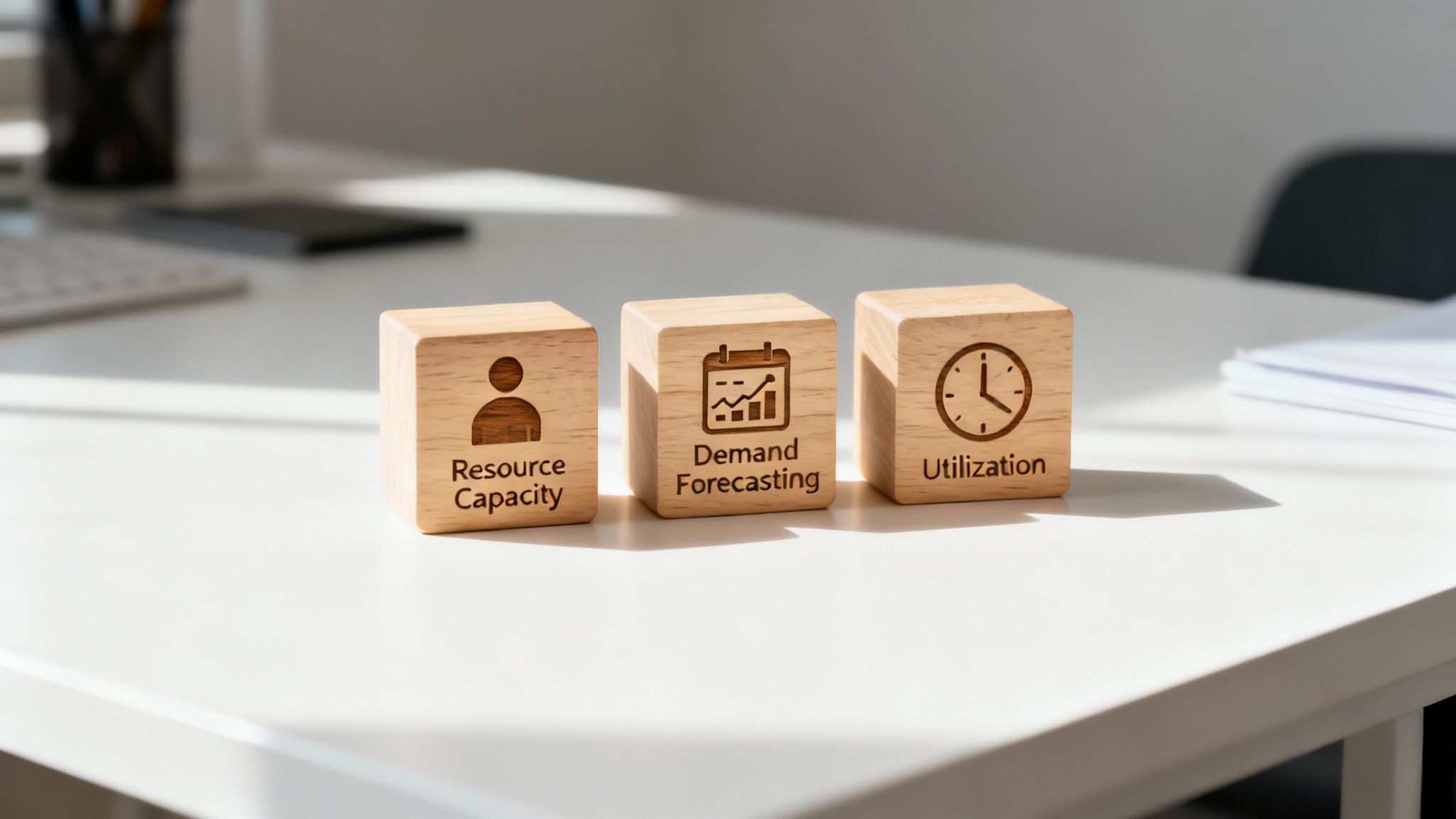
To really get what capacity planning is, you have to break it down into its core parts. Think of it like a sound mix. You can't just slam all the faders up; you have to understand how the dialogue, sound effects, and score work together. In planning, your key elements are resource capacity, demand forecast, and team utilisation.
Nailing these three gives you a complete picture of your studio's operational health. It’s the difference between making educated guesses and making sharp, data-backed decisions about projects, hiring, and growth. Let's break each one down in a way that actually makes sense in a creative studio.
Understanding Your Resource Capacity
First things first, you need to know what you’re working with. Resource capacity is the total amount of productive time your team and equipment can give you over a set period. It's the absolute maximum your studio could theoretically produce if everyone and everything was dedicated to client work every single second of every day.
For a VFX studio, that calculation involves:
- The available hours of every 3D modeller.
- The working time for all compositors and animators.
- The operational hours of your render farm and specialised suites.
But here’s the catch: simply multiplying employees by their weekly hours doesn't work. You have to subtract holidays, sick days, training sessions, and all the other non-project stuff. What’s left is your true resource capacity—a realistic measure of what you've got to offer.
Forecasting Future Project Demand
Once you know your supply, you need to predict the demand. Demand forecasting is the art and science of estimating the work coming down the pipeline. It means looking at both confirmed projects and potential deals to figure out what resources you'll need and when.
Think of it as your studio's weather forecast. It might not be 100% perfect, but it gives you a clear enough picture to prepare. A solid forecast helps you answer crucial questions like, "Will we need freelance colourists in three months?" or "Can we confidently take on that big advertising job in Q4?"
This process blends hard data from past projects with insights from your sales and client teams. Good forecasting is the foundation for effective scheduling of resources, ensuring you have the right talent lined up before the work even lands.
Capacity planning without a demand forecast is like storyboarding without a script. You might create some beautiful shots, but they won’t connect into a coherent, successful final product. You need to know where you're going to plan the journey effectively.
Measuring Team Utilisation
The final, crucial piece of the puzzle is utilisation. This metric shows you how much of your available capacity is actually being used for productive, billable work. It’s the bridge between what you can do (your capacity) and what you are doing (your projects), revealing how efficiently your team's time is creating value.
Utilisation is just a percentage. For instance, if a video editor has 40 available hours in a week and spends 32 of them on client projects, their utilisation rate is 80%. It’s a simple KPI, but it's incredibly powerful.
Tracking utilisation helps you:
- Identify team members who are over-utilised and heading for burnout.
- Spot under-utilised talent who could be trained or moved onto new tasks.
- Understand the real cost of non-billable time like internal meetings and admin.
By comparing your planned utilisation against what actually happens, you create a feedback loop. This helps you constantly refine your project estimates and boost your studio's profitability, making your whole capacity planning system smarter over time.
Why Effective Planning Is Your Competitive Edge
Let's move past the theory. What does solid capacity planning actually look like on the studio floor? It’s the difference between a studio that just about gets by and one that consistently nails it. Understanding the 'why' behind this discipline is what turns it from a chore into a serious competitive advantage, especially in the UK's fast-paced media world.
Picture two studios for a moment. Studio A runs on gut feelings and last-minute heroics. They quote projects based on optimism, cram schedules full, and live in a constant state of firefighting. Deadlines inevitably slip, leading to those awkward client calls that chip away at hard-won trust. The artists feel the relentless pressure, which leads to burnout and a quiet but costly exodus of your best talent.
When a massive project lands unexpectedly, it’s pure chaos. They have to scramble for expensive, last-minute freelancers, often paying a premium that completely guts their profit margins. This studio is always busy, but it's never truly profitable or stable.
The Rewards of Strategic Planning
Now, let's look at Studio B. They’ve embraced strategic planning. They have a clear, data-driven picture of what their team can realistically handle. This changes everything.
- Profitable Quoting: They send out quotes that accurately reflect the work involved, protecting their margins right from the start.
- Predictable Schedules: Clients love them for their reliability. Deadlines are met time and again because the schedules are based on reality, not wishful thinking.
- Talent Retention: Artists get to work in a stable, predictable environment. This sustainable pace actually fuels creativity and builds loyalty, slashing the high cost of staff turnover.
This is the real heart of capacity planning. It's about building a business that's more resilient, more respected, and ultimately, more profitable. It gives you the foresight to know when to hire, the confidence to price jobs correctly, and the stability to keep your creative team firing on all cylinders.
By understanding your capacity, you’re not just managing a schedule; you're steering the future of your studio. It allows you to make proactive choices about growth and profitability instead of constantly reacting to problems.
Fostering a Stable Creative Environment
A studio that plans well doesn't just deliver projects better; it builds a healthier culture. When workloads are balanced, your team can pour their energy into creative excellence instead of stressing about impossible deadlines. That kind of stability is a magnet for top-tier talent.
What's more, proper planning gives you the hard data to back up investment decisions. Think you need a new colourist or another editing suite? A capacity plan shows exactly when demand will outstrip your resources, turning a gut-feel request into a solid business case.
Ultimately, this foresight helps you properly manage team workload and avoid the burnout that plagues so much of the creative industry. Instead of just guessing, you can build a sustainable workflow that allows your team to do their best work without sacrificing their well-being. It’s a strategic move that pays for itself in quality, client satisfaction, and long-term success.
Your Guide to Implementing Capacity Planning
Moving from understanding what capacity planning is to actually doing it can feel like a huge leap. But here’s the good news: you don’t need a complicated, expensive system from day one. By breaking the process down into manageable stages, any studio can start building a smarter, more predictable workflow.
This isn’t about hitting perfection overnight. It’s about making steady, incremental progress. The aim is to build a simple, effective system that gives you the clarity you need to make better decisions about your projects and your team. Let's walk through the four key stages to get you started.
Stage 1: Audit Your Current Resources
Before you can plan for the future, you need a crystal-clear picture of the present. This first step is all about taking stock of your most valuable asset: your team. It means looking beyond mere job titles to really understand the skills and the actual availability you have at your disposal.
A great place to start is with a skills matrix. This is just a simple spreadsheet that lists every team member and maps out their specific competencies. Who are your After Effects wizards? Who has advanced colour grading skills? This document quickly becomes your go-to guide for matching the right talent to the right tasks.
Next, you have to calculate your team's true availability. Don't just multiply the number of employees by their contracted hours. You need to account for all the non-billable time that eats into the week, including:
- Annual leave and public holidays
- Internal meetings and administrative tasks
- Training and professional development days
- Company events and team-building activities
Subtracting this time from the total contracted hours gives you a realistic baseline for your studio’s genuine productive capacity.
Stage 2: Build a Simple Forecasting System
With a firm grasp of your available resources, the next stage is to forecast future demand. This doesn’t require a crystal ball—just a bit of structured thinking based on the data you already have. Your forecast will draw from two main sources: past projects and your current sales pipeline.
Start by digging into recently completed projects. How many hours did that commercial actually take? What skills were most in demand? This historical data is gold for creating more accurate estimates for new, similar projects.
Then, turn your attention to the sales pipeline. Categorise potential projects by their likelihood of closing, perhaps using percentages (e.g., 75% likely, 50% likely). This helps you build a weighted forecast, giving you a more nuanced view of the potential future workload rather than a simple all-or-nothing picture.
A simple forecast, even if it's just in a shared spreadsheet, is one of the most powerful tools you can create. It transforms your studio from being reactive to proactive, allowing you to anticipate resource bottlenecks weeks or even months in advance.
The process flow below visualises the stark difference between a studio that plans and one that doesn’t.

As you can see, poor planning leads to a reactive cycle of chaos and burnout. In contrast, good planning creates a proactive loop of stability, growth, and happy clients.
Stage 3: Adopt Structured Resource Scheduling
This is where you connect your supply (your team) with your demand (your projects). Moving beyond chaotic, last-minute assignments is absolutely essential for efficiency. Structured scheduling is all about creating a clear, visible plan for who is working on what, and when.
Begin by scheduling at a high level. Block out resources for specific projects on a weekly or even monthly basis. This "soft booking" gives you an early view of potential conflicts or gaps in your plan. As project details become clearer, you can then refine these into more granular, daily assignments.
The key here is visibility. Whether you use a dedicated software tool or a shared calendar, everyone on the team should be able to see the plan. This transparency helps manage expectations, cuts down on confusion, and empowers project managers to make smarter allocation decisions. To really put this into action, you can explore these effective capacity planning strategies tailored for creative businesses.
Stage 4: Create a Consistent Review Cadence
A capacity plan isn't a static document you create once and then forget about. It's a living system that needs regular attention to stay useful. Establishing a consistent review cadence is the final, crucial step to making capacity planning a sustainable practice in your studio.
Implement a regular cycle of reviewing and adjusting the plan:
- Weekly Check-ins: Hold a quick, tactical meeting to review the upcoming week's schedule. This is the time for making small adjustments based on immediate project needs or unexpected staff absences.
- Monthly Reviews: Take a more strategic look at the month ahead. Compare your forecast against the actual booked work. Are you on track? Do you need to adjust your sales focus or start looking for freelancers?
- Quarterly Planning: This is a high-level review of the past quarter to improve future forecasts. Analyse utilisation rates and project profitability to spot trends and make bigger strategic decisions about hiring and training.
This continuous feedback loop is what makes your capacity planning process truly work. It allows you to learn from experience, refine your estimates, and steadily improve your ability to balance workload and resources—leading to a more profitable and stable studio.
Common Capacity Planning Mistakes to Avoid
Taking on capacity planning is a massive leap forward for any studio, but it’s a path littered with predictable tripwires. Seeing these common pitfalls ahead of time is the secret to building a system that actually works in the real world, not just on a spreadsheet. Side-step these, and your planning efforts will lead to genuine boosts in efficiency and, just as importantly, your team's well-being.
The most common trap? Grossly underestimating non-billable time. It’s so easy to look at a 40-hour week and slot in 40 hours of project work, but that completely ignores the reality of studio life. Internal meetings, admin, training, even those vital coffee breaks—they all add up, creating a massive gap between what you planned and what your team can actually deliver.
Overlooking the Unseen Workload
Forgetting this internal "cost of doing business" is a direct flight to blown deadlines and team burnout. The fix is simple: treat non-billable time like its own project. Track it. Log it. Give it the same respect you give client work. This will quickly give you a data baseline, often revealing that a solid 15-25% of your team's time is eaten up by essential, non-project activities.
A capacity plan that doesn't honestly account for internal tasks isn't a plan; it's a wish list. Acknowledging and scheduling this time is the single most important step towards creating realistic and achievable project timelines.
When you do this, you’re baking a buffer into your schedules from the get-go. It instantly makes your entire planning process more grounded and trustworthy.
The Pitfall of Perpetual Optimism
Another classic mistake is mapping out projects based on best-case scenarios. Let's be honest, creative work is rarely a straight line from A to B. Scope creep, unexpected feedback, and technical gremlins aren't exceptions; they're part of the job. Planning as if every project will go off without a hitch is setting your team up to fail before they’ve even started.
The antidote is a contingency buffer. This isn't about padding estimates to look good; it's a strategic reserve of time set aside to handle the inevitable curveballs. A buffer of 10-20% on project timelines can be the difference between a last-minute panic and a calm, professional response to challenges.
Here are a few other frequent missteps to watch out for:
- Using Rigid Tools: Creative workflows need to breathe. A planning tool that locks you into a rigid structure will cause more problems than it solves. Look for flexible software that makes it easy to drag, drop, and adjust on the fly.
- Ignoring Historical Data: Every project you finish is a goldmine of data. If you’re not looking back at how long things actually took, you’re doomed to repeat the same estimation errors over and over again.
- Planning in a Silo: Capacity planning can't be a one-person show. You have to involve your project managers and team leads. They’re the ones on the ground who know the practical realities of getting the work done.
By getting out in front of these issues, you move beyond just knowing what capacity planning is and start mastering how to execute it effectively. This turns your plan from a fragile document into a robust operational tool—one built to handle the chaotic, dynamic nature of creative production and guide your studio to real, long-term success.
The Future of Planning with AI-Powered Tools
Traditional capacity planning has always walked a fine line between art and science, leaning heavily on manual effort and educated guesswork. But as studios juggle more complex projects with tighter turnarounds, this old model is starting to creak under the pressure. The future isn't about working harder; it's about planning smarter. And that's where artificial intelligence comes in.
AI-powered tools are shifting capacity planning from a reactive chore into a proactive, intelligent, strategic advantage. Think of it less like a static spreadsheet and more like a dynamic, self-adjusting GPS for your studio. These systems can chew through enormous amounts of historical project data in seconds, spotting hidden patterns in timelines, resource usage, and profitability that would be invisible to the human eye.
This allows them to generate astonishingly accurate forecasts. Instead of just looking at last quarter's numbers, an AI can analyse years of data to predict upcoming demand with far greater precision. This gives you a much clearer runway for big decisions. To really get a handle on this, it's worth understanding the various AI tools available for content creation and how they can be adapted for operational needs.
From Manual Analysis to Automated Insight
One of the most immediate wins with AI is its ability to automate the heavy lifting of data analysis. Instead of project managers losing hours poring over timesheets and schedules, an AI-enabled system can surface key insights instantly. It can flag potential resource bottlenecks weeks in advance or highlight artists who are consistently over-utilised and at risk of burnout.
This automation frees up your team to focus on what they do best: creative problem-solving and nurturing client relationships. The system handles the number crunching, while your people drive the strategy.
The real power of AI in capacity planning isn’t just about speed; it's about depth. It moves you from asking "What happened?" to proactively answering "What's likely to happen next, and what should we do about it?"
This approach is already being used to manage incredibly complex systems. To tackle similar capacity challenges, UK data centre operators are now integrating management systems with digital twins. This combination allows for real-time monitoring and predictive modelling to get the most out of their existing infrastructure.
Running What-If Scenarios in Seconds
Perhaps the most potent application for studios is the ability to run sophisticated 'what-if' scenarios on the fly. What happens if you take on that huge new streaming series? What's the real impact of a key artist taking a two-week holiday during a critical project phase?
Instead of relying on gut feel, you can model these scenarios in an instant. An AI tool like freispace can simulate the impact on your entire schedule, budget, and resource pool, showing you all the ripple effects before you commit.
This capability completely changes the game for quoting and sales. It turns reactive firefighting into proactive, data-driven decision-making, giving you the confidence to chase ambitious projects and fuel sustainable growth. The future isn't just about knowing your capacity; it's about intelligently optimising it.
Got Questions About Capacity Planning?
Even with a perfect plan on paper, questions always pop up when studios start putting capacity planning into practice. Let's tackle some of the most common ones we hear to clear up any confusion and get you moving forward.
How Often Should We Be Looking at Our Capacity Plan?
Your capacity plan isn't a "set it and forget it" document; think of it as a living, breathing part of your studio's operations. For most creative teams, a tiered review schedule works wonders. A quick, high-level check-in weekly is perfect for making small adjustments to current projects and stamping out any unexpected fires.
Then, you need a deeper dive monthly or quarterly. This is where you zoom out. You'll update your forecasts with what the sales pipeline is telling you, look at how well your teams are being utilised, and make the bigger calls—like hiring new talent, investing in training, or buying that new equipment you've been eyeing. This rhythm keeps your plan grounded in reality.
What's the Real Difference Between Resource Planning and Capacity Planning?
This one trips a lot of people up, but the distinction is critical. They sound similar, but they operate on completely different altitudes and timelines.
- Resource Planning is the ground-level, short-term game. It’s the nitty-gritty of assigning a specific person to a specific task for a specific project. It answers the question, "Who's doing what today?"
- Capacity Planning is the 30,000-foot strategic view. It’s about making sure you have the right number of people with the right skills (your total capacity) to handle all the work you expect to land over the next few months or even the next year. It answers the question, "Will we have the team we need for what's coming?"
You can't really do one without the other. Resource planning happens inside the bigger container that capacity planning builds.
You can’t schedule your artists effectively if you don’t know whether you have enough artists in the first place. Capacity planning gives you the strategy; resource planning is how you execute it on the ground.
Our Studio's Workload Is All Over the Place. Can We Still Plan Capacity?
Yes, absolutely. In fact, when your workload is unpredictable, capacity planning is even more valuable. The aim isn't to create a rigid plan that shatters the moment an unexpected project walks in the door. It's about building a flexible framework that helps you make smart decisions on the fly.
For studios with a volatile pipeline, you build forecasts based on different scenarios: best-case, worst-case, and most-likely. This process shows you the core team you need no matter what, highlights potential gaps before they become emergencies, and gives you a clear trigger for when to bring in your trusted freelancers.
Ready to swap chaotic schedules for a predictable, profitable workflow? See how freispace uses AI-native tools to make capacity planning straightforward and incredibly effective. Discover a smarter way to schedule at freispace.com.

